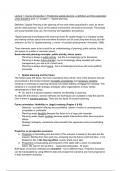Samenvatting
Samenvatting Spatial Planning – an exploration of the discipline(GEO2-3122) GOING DUTCH 2024
- Instelling
- Universiteit Utrecht (UU)
(STUUR MIJ EEN DM VOOR KORTING! Dit document bevat een samenvatting van het boek 'An Introduction to Spatial Planning in the Netherlands' van Patrick Witte and Thomas Hartmann. Deze samenvatting is Engels. Inclusief drie artikelen: “Planning and the 'stubborn realities' of global south-east ci...
[Meer zien]




